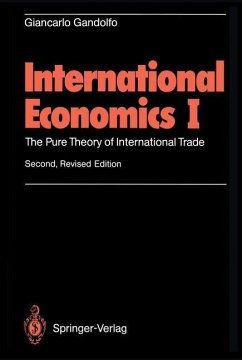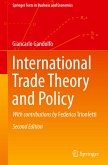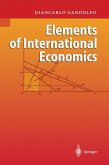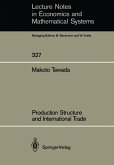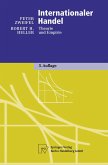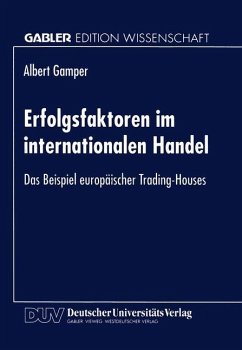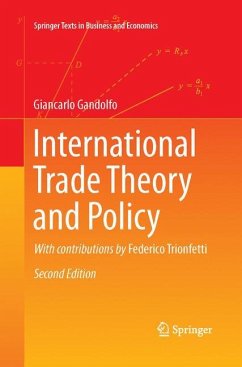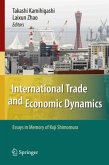- Broschiertes Buch
- Merkliste
- Auf die Merkliste
- Bewerten Bewerten
- Teilen
- Produkt teilen
- Produkterinnerung
- Produkterinnerung
This textbook, in addition to the traditional topics of international trade theory, integrates many topics omitted from other texts, plus new research results so that it is also useful as a reference book. It is designed for use at both undergraduate and graduate level. This is possible because of its unique "two-tier" structure: the text speaks directly to the undergraduate in extremly clear verbal and graphic terms; the appendices, which form the second tier, are addressed to the graduate student and the researcher and are self-contained treatments in mathematical terms of the topics…mehr
Andere Kunden interessierten sich auch für
![International Trade Theory and Policy International Trade Theory and Policy]() Giancarlo GandolfoInternational Trade Theory and Policy91,99 €
Giancarlo GandolfoInternational Trade Theory and Policy91,99 €![Elements of International Economics Elements of International Economics]() Giancarlo GandolfoElements of International Economics38,99 €
Giancarlo GandolfoElements of International Economics38,99 €![Production Structure and International Trade Production Structure and International Trade]() Makoto TawadaProduction Structure and International Trade39,99 €
Makoto TawadaProduction Structure and International Trade39,99 €![Internationaler Handel Internationaler Handel]() Peter ZweifelInternationaler Handel39,99 €
Peter ZweifelInternationaler Handel39,99 €![Erfolgsfaktoren im internationalen Handel Erfolgsfaktoren im internationalen Handel]() Albert GamperErfolgsfaktoren im internationalen Handel49,99 €
Albert GamperErfolgsfaktoren im internationalen Handel49,99 €![International Trade Theory and Policy International Trade Theory and Policy]() Giancarlo GandolfoInternational Trade Theory and Policy65,99 €
Giancarlo GandolfoInternational Trade Theory and Policy65,99 €![International Trade and Economic Dynamics International Trade and Economic Dynamics]() International Trade and Economic Dynamics75,99 €
International Trade and Economic Dynamics75,99 €-
-
-
This textbook, in addition to the traditional topics of international trade theory, integrates many topics omitted from other texts, plus new research results so that it is also useful as a reference book. It is designed for use at both undergraduate and graduate level. This is possible because of its unique "two-tier" structure: the text speaks directly to the undergraduate in extremly clear verbal and graphic terms; the appendices, which form the second tier, are addressed to the graduate student and the researcher and are self-contained treatments in mathematical terms of the topics examined in the text. The ample and balanced treatment of the various approaches and the clarity of exposition ensure that the reader gains a thorough grasp of theories, facts and policies.
Hinweis: Dieser Artikel kann nur an eine deutsche Lieferadresse ausgeliefert werden.
Hinweis: Dieser Artikel kann nur an eine deutsche Lieferadresse ausgeliefert werden.
Produktdetails
- Produktdetails
- Verlag: Springer / Springer Berlin Heidelberg / Springer, Berlin
- Artikelnr. des Verlages: 978-3-540-58133-8
- 2nd, rev. ed.
- Seitenzahl: 372
- Erscheinungstermin: 31. August 1994
- Englisch
- Abmessung: 242mm x 170mm x 21mm
- Gewicht: 530g
- ISBN-13: 9783540581338
- ISBN-10: 3540581332
- Artikelnr.: 03553517
- Herstellerkennzeichnung Die Herstellerinformationen sind derzeit nicht verfügbar.
- Verlag: Springer / Springer Berlin Heidelberg / Springer, Berlin
- Artikelnr. des Verlages: 978-3-540-58133-8
- 2nd, rev. ed.
- Seitenzahl: 372
- Erscheinungstermin: 31. August 1994
- Englisch
- Abmessung: 242mm x 170mm x 21mm
- Gewicht: 530g
- ISBN-13: 9783540581338
- ISBN-10: 3540581332
- Artikelnr.: 03553517
- Herstellerkennzeichnung Die Herstellerinformationen sind derzeit nicht verfügbar.
1 Introduction.- 1.1 International Economics as a distinct subject.- 1.2 The pure theory of international trade: an overview.- References.- 2 The classical (Ricardo-Torrens) theory of comparative costs.- 2.1 Comparative costs (advantages) and international trade.- 2.2 Alternative graphic representations.- 2.3 A modern interpretation in terms of optimization.- 2.4 Generalizations.- 2.5 The problem of the determination of the terms of trade.- References.- 3 The neoclassical theory of international trade.- 3.1 The transformation curve and the box diagram.- 3.2 General equilibrium in a simple closed economy.- 3.3 General equilibrium in open economies and international trade.- 3.4 Marshallian reciprocal demand curves, international equilibrium, and stability.- 3.5 Increasing returns to scale.- 3.6 The gains from trade.- 3.7 Generalizations.- References.- 4 The Heckscher-Ohlin model.- 4.1 Basic assumptions and their meaning.- 4.2 Proof of the fundamental theorem.- 4.3 Factor price equalization.- 4.4 Extensions and qualifications.- 4.5 Leontief's paradox and other empirical studies.- References.- 5 Tariffs, protection, economic integration.- 5.1 Introduction.- 5.2 Partial equilibrium effects of a tariff.- 5.3 The so-called social costs of a tariff.- 5.4 General equilibrium effects of a tariff.- 5.5 Quotas and other non-tariff barriers.- 5.6 Free trade versus protection and the theory of second best.- 5.7 Intermediate goods and the effective rate of protection.- 5.8 Customs unions and economic integration.- 5.9. The "new" protectionism.- References.- 6 International trade and economic growth.- 6.1 Introduction.- 6.2 The effects of growth on the volume of trade.- 6.3 Growth and terms of trade; immiserizing growth.- 6.4 Increase in factor endowments and international trade:Rybczynski's theorem.- 6.5 Technical progress and international trade.- 6.6 Dynamic models.- References.- 7 Some refinements of the orthodox theory.- 7.1 Introduction.- 7.2 Transport costs and international trade.- 7.3 Intermediate goods.- 7.4 Elastic factor supply.- 7.5 Non-traded goods.- 7.6 Natural resources, specific productive factors, "Dutch disease" and de-industrialization.- 7.7 International factor mobility.- 7.8 International trade under uncertainty.- 7.9 Illegal transactions in international trade and the economic theory of smuggling.- References.- 8 The New Theories of International Trade.- 8.1 Introduction.- 8.2 The precursors.- 8.3 Neo-Heckscher-Ohlin theories.- 8.4 Monopolistic competition and international trade.- 8.5 Oligopoly and international trade.- References.- 9 Neo-Ricardian theories of international trade.- 9.1 Intermediate and capital goods in the orthodox theory.- 9.2 The debate between the orthodox theory and the neo-Ricardian theories.- References.- Name Index.
1 Introduction.- 1.1 International Economics as a distinct subject.- 1.2 The pure theory of international trade: an overview.- References.- 2 The classical (Ricardo-Torrens) theory of comparative costs.- 2.1 Comparative costs (advantages) and international trade.- 2.2 Alternative graphic representations.- 2.3 A modern interpretation in terms of optimization.- 2.4 Generalizations.- 2.5 The problem of the determination of the terms of trade.- References.- 3 The neoclassical theory of international trade.- 3.1 The transformation curve and the box diagram.- 3.2 General equilibrium in a simple closed economy.- 3.3 General equilibrium in open economies and international trade.- 3.4 Marshallian reciprocal demand curves, international equilibrium, and stability.- 3.5 Increasing returns to scale.- 3.6 The gains from trade.- 3.7 Generalizations.- References.- 4 The Heckscher-Ohlin model.- 4.1 Basic assumptions and their meaning.- 4.2 Proof of the fundamental theorem.- 4.3 Factor price equalization.- 4.4 Extensions and qualifications.- 4.5 Leontief's paradox and other empirical studies.- References.- 5 Tariffs, protection, economic integration.- 5.1 Introduction.- 5.2 Partial equilibrium effects of a tariff.- 5.3 The so-called social costs of a tariff.- 5.4 General equilibrium effects of a tariff.- 5.5 Quotas and other non-tariff barriers.- 5.6 Free trade versus protection and the theory of second best.- 5.7 Intermediate goods and the effective rate of protection.- 5.8 Customs unions and economic integration.- 5.9. The "new" protectionism.- References.- 6 International trade and economic growth.- 6.1 Introduction.- 6.2 The effects of growth on the volume of trade.- 6.3 Growth and terms of trade; immiserizing growth.- 6.4 Increase in factor endowments and international trade:Rybczynski's theorem.- 6.5 Technical progress and international trade.- 6.6 Dynamic models.- References.- 7 Some refinements of the orthodox theory.- 7.1 Introduction.- 7.2 Transport costs and international trade.- 7.3 Intermediate goods.- 7.4 Elastic factor supply.- 7.5 Non-traded goods.- 7.6 Natural resources, specific productive factors, "Dutch disease" and de-industrialization.- 7.7 International factor mobility.- 7.8 International trade under uncertainty.- 7.9 Illegal transactions in international trade and the economic theory of smuggling.- References.- 8 The New Theories of International Trade.- 8.1 Introduction.- 8.2 The precursors.- 8.3 Neo-Heckscher-Ohlin theories.- 8.4 Monopolistic competition and international trade.- 8.5 Oligopoly and international trade.- References.- 9 Neo-Ricardian theories of international trade.- 9.1 Intermediate and capital goods in the orthodox theory.- 9.2 The debate between the orthodox theory and the neo-Ricardian theories.- References.- Name Index.

